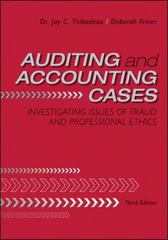On October 12, 2001, after reading through some of Andersens internal memos related to the Enron audits,
Question:
On October 12, 2001, after reading through some of Andersen’s internal memos related to the Enron audits, one of Andersen’s lawyers, Nancy Temple, advised Andersen’s practice director in Houston, Michael Odom, in an e-mail as follows:
“It might be useful to consider reminding the engagement team of our documentation and retention policy. It will be helpful to make sure that we have complied with the policy.
Two days earlier, Odom had given a videotaped presentation on the firm’s document-retention policy, in which he said that any documents that were not essential to the audit file (drafts, notes, internal memos, and e-mails) should be discarded, unless a lawsuit had been filed. “If it’s destroyed in the course of normal policy and litigation is filed the next day, that’s great, you know, because we’ve followed our own policy, and whatever there was that might have been of interest to somebody is gone and irretrievable.”5 Andersen’s In-House Lawyers On October 16, Enron announced its third-quarter results, which included a loss of \($638\) million and a reduction of shareholder equity of \($1.2\) billion. Its stock price fell almost 40 percent in the following week alone. That same day, Temple e-mailed David Duncan, the lead engagement partner for the Enron audit, with suggestions on how he should edit his memo that documented auditing-related events surrounding Enron’s third-quarter earnings release.
One of her suggestions was to delete his “reference to consultation with the legal group” as well as deleting her name from the memo. “Reference to the legal group consultation arguably is a waiver of attorney-client privilege and if my name is mentioned it increases the chances that I might be a witness, which I prefer to avoid,” she wrote. Temple continued to edit internal memos. At one point, she even suggested deleting senior Andersen partners from the distribution list for Enron-related e-mails to decrease their likelihood of being called as witnesses in any subsequent litigation.6 Document Shredding Seven days later, on October 23, the SEC announced its investigation into the Enron matter. That afternoon, Duncan gathered the members of his audit team and reminded them that they needed to make sure they complied with the firm’s document-retention policy. Shortly after, Andersen’s Houston office started shredding documents from the Enron audit files. Andersen’s auditors wound up sending files it maintained onsite at Enron to its main downtown office.
The amount it sent to be shredded was more than the entire Houston office typically shredded in an entire year. Andersen eventually hired a shredding truck from a local disposal company called Shred-It. In addition, its offices in London, Portland, and Chicago began helping to shred documents. Andersen also destroyed almost all of the computer files and e-mail messages that related to Enron’s audits.7 On November 9, Andersen stopped shredding documents related to the Enron audits after it received a subpoena from the SEC the day before.8 Duncan’s assistant sent the following e-mail: “Per Dave: no more shredding. If you are asked, tell them Dave said we can’t. We’ve been officially served by the attorneys for our documents.”9 In January 2002, Andersen fired Duncan for his lead role in the shredding of documents. After Duncan pled guilty to the crime of obstruction of justice, the U.S. Justice Department filed a criminal indictment against Andersen in March 2002. The entire firm was indicted because of the several offices that had worked on the Enron account and that had been involved with shredding documents.
The indictment signaled the beginning of the end for Enron’s auditor Arthur Andersen LLP, one of the five largest international public accounting firms.
In May 2002, Andersen was convicted on one charge of obstruction of justice in connection with the shredding of documents related to the Enron audit. And although this conviction was overturned in May 2005 by the United States Supreme Court, Andersen’s decision to destroy evidence cast suspicion on whether Andersen was trying to cover up any guilt related to a failure to perform its professional responsibilities.
Case Questions
1. Define audit documentation. Why is it important for an auditor to retain audit documentation for a specific period of time?
2. Do you believe that this provision of the law goes far enough; that is, do you believe that the law is adequate related to audit documentation requirements? Why or why not?
3. In your own words, describe what is expected to be documented in the audit workpapers for each relevant financial statement assertion.
4. Do you believe that the shredding of documents acquired during the audit process still occurs? Why or why not?
5. Consider the actions of Andersen lawyer Nancy Temple and practice director Michael Odom. Do you believe that their actions were appropriate under the circumstances? Why or why not?
Step by Step Answer:

Auditing And Accounting Cases Investigating Issues Of Fraud And Professional Ethics
ISBN: 9780078110818
3rd Edition
Authors: Jay Thibodeau, Deborah Freier





